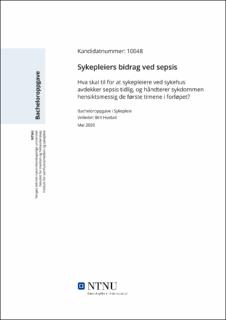| dc.contributor.advisor | Hustad, Brit | |
| dc.contributor.author | Haavelsrud, Andreas | |
| dc.date.accessioned | 2020-07-17T16:02:25Z | |
| dc.date.available | 2020-07-17T16:02:25Z | |
| dc.date.issued | 2020 | |
| dc.identifier.uri | https://hdl.handle.net/11250/2669542 | |
| dc.description.abstract | Tittel: Sykepleiers bidrag ved sepsis.
Hensikt: Hensikten med dette litteraturstudiet er å avdekke faktorer og forhold som hjelper og begrenser sykepleiere i prosessen med både å avdekke sepsis, og følge opp
septiske pasienter hensiktsmessig de første timene i forløpet.
Problemstilling: Hva skal til for at sykepleiere ved sykehus avdekker sepsis tidlig, og håndterer sykdommen hensiktsmessig de første timene i forløpet?
Metode: En litteraturstudie som tar for seg ni artikler som belyser systematisk sepsisbehandling og forhold som bidrar til dette.
Resultat: Sykepleier ble i litteraturen tillagt en sentral og viktig rolle i forbindelse med tidlig avdekking og oppfølging av den septiske pasient. De viktigste faktorene som spilte i
sykepleiers favør var: helhetlige, planlagte forløp som klargjorde ansvarsforhold og tiltak,
screeningverktøy og pakkeforløp som var utviklet i tråd med internasjonale retningslinjer, og ble tilpasset lokale forhold i samråd med sykepleiere, undervisning og oppfølging ved arbeidsplass, en tydelig ledelse som satt problemstillingen på agendaen, tilstrekkelig kvalifisert personale på jobb og velfungerende kliniske mikrosystemer som hadde fokus på tverrfaglig samarbeid. Momenter som begrenset sykepleiere, var i hovedsak svakheter og begrensninger ved overnevnte faktorer.
Konklusjon: Utvalgt litteratur viser at gode organisatoriske forhold, god klinisk og teoretisk kompetanse og hensiktsmessig implementerte screeningverktøy og standardiserte pasientforløp, bidrar til at sykepleier avdekker sepsis tidligere, og hjelper sykepleier å gi pasienten hensiktsmessig oppfølging de første timene i forløpet. | |
| dc.description.abstract | Title: Nurse's contribution to the septic patient.
Aims/purpose: The purpose of this literature study is to reveal factors and conditions that help and limit nurses in the process of both detecting sepsis and appropriately following up septic patients for the first few hours of the course of the disease.
Research question: What is needed for hospital nurses to detect sepsis early and to deal with the disease appropriately for the first few hours of the course?
Method: A literature study that deals with nine articles that elucidate systematic sepsis treatment and factors that contribute to this.
Result: In the literature, nurses were assigned a central and important role related to early detection and care of the septic patient. The most important factors that played in the nurse's favor were: comprehensive, planned processes that clarified responsibilities and measures, screening tools and package programs that were developed in accordance with international guidelines and were adapted to local conditions in consultation with nurses, teaching and follow-up at the workplace, clear management which put the issue on the agenda, sufficiently qualified staff at work and well-functioning clinical microsystems that focused on interdisciplinary collaboration. Moments that limited nurses were mainly weaknesses and limitations of the above factors.
Conclusion: Selected literature shows that good organizational conditions, good clinical and theoretical expertise, and appropriately implemented screening tools and standardized patient care, help the nurse detect sepsis early, and help the nurse provide appropriate care for the first few hours of the course of the disease. | |
| dc.publisher | NTNU | |
| dc.title | Sykepleiers bidrag ved sepsis | |
| dc.type | Bachelor thesis | |
